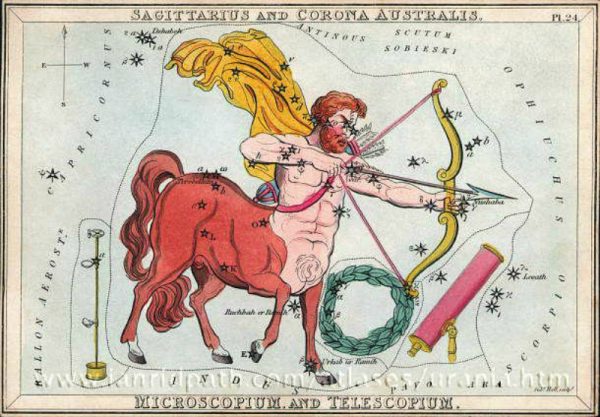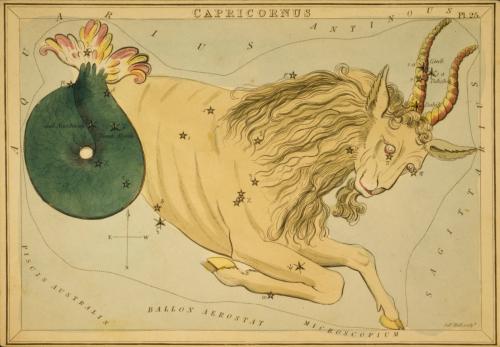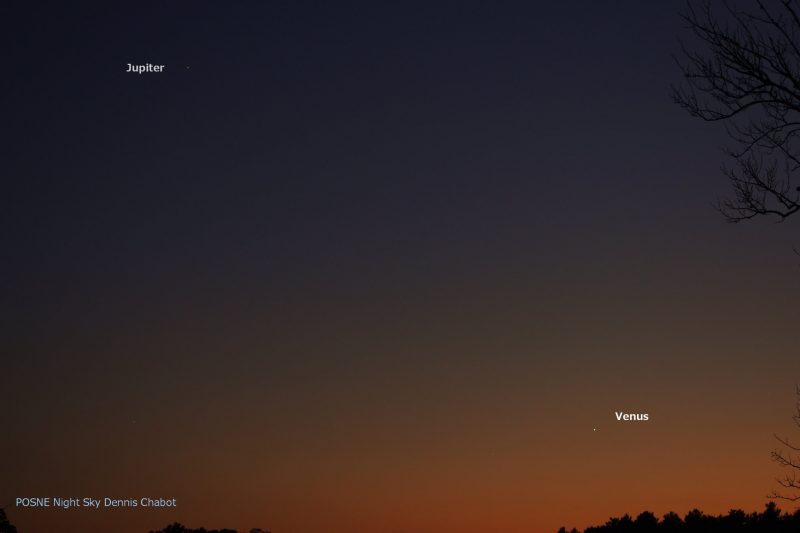
On September 17, 18 and 19, 2018, use the waxing gibbous moon to locate the planets Saturn and Mars. These two worlds look like bright stars, and they are easy to see with the eye alone. Mars is the brighter of the two, its ruddy color contrasting beautifully with the golden hue of Saturn.
If you have a telescope, use it to enjoy Saturn’s glorious rings.
The moon, Saturn and Mars shine highest up for the night at or around nightfall. They slowly sink westward throughout the evening and wee morning hours. As viewed from northerly latitudes, all three worlds appear rather low in the southern sky at nightfall; from the Southern Hemisphere, on the other hand, the moon, Saturn and Mars shine way up high as darkness falls.

On the evening of September 15, 2018, the moon was approaching Saturn. Image via Dennis Chabot of POSNE Night Sky. He wrote: “Saturn and Mars and our moon are shining bright … just beautiful.”
Saturn lodges in front of the constellation Sagittarius the Archer. Mars resides in front of the constellation Capricornus the Seagoat. These are winter constellations for the Northern Hemisphere yet summer constellations for the Southern Hemisphere.
When the sun passes through the far-southern constellations Sagittarius and Capricornus, it’s winter in the Northern Hemisphere and the daytime sun sits low in the Northern Hemisphere sky. As viewed from the Southern Hemisphere, however, it’s summer when the sun is “in” Sagittarius and Capricornus and the daytime sun appears high in the sky. The same applies to the moon and planets when they reside in front of Sagittarius and Capricornus – low in the sky for the Northern Hemisphere and high in the sky for the Southern Hemisphere.

Sagittarius the Archer via Urania’s Mirror.

Capricornus the Sea-goat via Urania’s Mirror.
Many of us know that the sun stays above the horizon for a longer period of time in summer than in winter. The same applies to the moon and planets, depending on whether they’re in front of a summer or winter constellation. For this reason, in September 2018, Saturn and Mars stay out longer after dark in the Southern Hemisphere than they do in the Northern Hemisphere.
Click here to know the moon’s current position in front of zodiac
The moon travels full circle in front the constellations of the zodiac every month. Some two weeks from now, look for the moon to be traveling through the far-northern constellations Taurus the Bull and Gemini the Twins. Taurus and Gemini are summer constellations for the Northern Hemisphere and winter constellations for the Southern Hemisphere.
So watch for the planets! And notice the stars behind them. Throughout September and October 2018, Saturn and Mars will continue to light up the constellations Sagittarius and Capricornus, respectively. And, remember … Saturn and Mars aren’t the only planets up after sunset. There are a total of four bright planets in the evening sky now. Jupiter and Venus are there, too! Watch for Jupiter and Venus – the sky’s brightest planets – in the western part of the sky shortly after sunset.

Dennis Chabot of POSNE Night Sky in Massachusetts also caught Venus and Jupiter on September 15, 2018. He wrote: “The sky is filled with planets tonight!” Read more.
Bottom line: On September 17, 18 and 19, 2018 – as soon as darkness falls – let the moon serve as your guide to two bright and beautiful planets, Saturn and Mars.
from EarthSky https://ift.tt/2NPM1Od

On September 17, 18 and 19, 2018, use the waxing gibbous moon to locate the planets Saturn and Mars. These two worlds look like bright stars, and they are easy to see with the eye alone. Mars is the brighter of the two, its ruddy color contrasting beautifully with the golden hue of Saturn.
If you have a telescope, use it to enjoy Saturn’s glorious rings.
The moon, Saturn and Mars shine highest up for the night at or around nightfall. They slowly sink westward throughout the evening and wee morning hours. As viewed from northerly latitudes, all three worlds appear rather low in the southern sky at nightfall; from the Southern Hemisphere, on the other hand, the moon, Saturn and Mars shine way up high as darkness falls.

On the evening of September 15, 2018, the moon was approaching Saturn. Image via Dennis Chabot of POSNE Night Sky. He wrote: “Saturn and Mars and our moon are shining bright … just beautiful.”
Saturn lodges in front of the constellation Sagittarius the Archer. Mars resides in front of the constellation Capricornus the Seagoat. These are winter constellations for the Northern Hemisphere yet summer constellations for the Southern Hemisphere.
When the sun passes through the far-southern constellations Sagittarius and Capricornus, it’s winter in the Northern Hemisphere and the daytime sun sits low in the Northern Hemisphere sky. As viewed from the Southern Hemisphere, however, it’s summer when the sun is “in” Sagittarius and Capricornus and the daytime sun appears high in the sky. The same applies to the moon and planets when they reside in front of Sagittarius and Capricornus – low in the sky for the Northern Hemisphere and high in the sky for the Southern Hemisphere.

Sagittarius the Archer via Urania’s Mirror.

Capricornus the Sea-goat via Urania’s Mirror.
Many of us know that the sun stays above the horizon for a longer period of time in summer than in winter. The same applies to the moon and planets, depending on whether they’re in front of a summer or winter constellation. For this reason, in September 2018, Saturn and Mars stay out longer after dark in the Southern Hemisphere than they do in the Northern Hemisphere.
Click here to know the moon’s current position in front of zodiac
The moon travels full circle in front the constellations of the zodiac every month. Some two weeks from now, look for the moon to be traveling through the far-northern constellations Taurus the Bull and Gemini the Twins. Taurus and Gemini are summer constellations for the Northern Hemisphere and winter constellations for the Southern Hemisphere.
So watch for the planets! And notice the stars behind them. Throughout September and October 2018, Saturn and Mars will continue to light up the constellations Sagittarius and Capricornus, respectively. And, remember … Saturn and Mars aren’t the only planets up after sunset. There are a total of four bright planets in the evening sky now. Jupiter and Venus are there, too! Watch for Jupiter and Venus – the sky’s brightest planets – in the western part of the sky shortly after sunset.

Dennis Chabot of POSNE Night Sky in Massachusetts also caught Venus and Jupiter on September 15, 2018. He wrote: “The sky is filled with planets tonight!” Read more.
Bottom line: On September 17, 18 and 19, 2018 – as soon as darkness falls – let the moon serve as your guide to two bright and beautiful planets, Saturn and Mars.
from EarthSky https://ift.tt/2NPM1Od

Aucun commentaire:
Enregistrer un commentaire